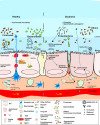Research progress on the relationship between intestinal microecology and intestinal bowel disease
- PMID: 35962562
- PMCID: PMC9434592
- DOI: 10.1002/ame2.12262
Research progress on the relationship between intestinal microecology and intestinal bowel disease
Abstract
Intestinal microecology is the main component of human microecology. Intestinal microecology consists of intestinal microbiota, intestinal epithelial cells, and intestinal mucosal immune system. These components are interdependent and establish a complex interaction network that restricts each other. According to the impact on the human body, there are three categories of symbiotic bacteria, opportunistic pathogens, and pathogenic bacteria. The intestinal microecology participates in digestion and absorption, and material metabolism, and inhibits the growth of pathogenic microorganisms. It also acts as the body's natural immune barrier, regulates the innate immunity of the intestine, controls the mucosal barrier function, and also participates in the intestinal epithelial cells' physiological activities such as hyperplasia or apoptosis. When the steady-state balance of the intestinal microecology is disturbed, the existing core intestinal microbiota network changes and leads to obesity, diabetes, and many other diseases, especially irritable bowel syndrome, inflammatory bowel disease (IBD), and colorectal malignancy. Intestinal diseases, including tumors, are particularly closely related to intestinal microecology. This article systematically discusses the research progress on the relationship between IBD and intestinal microecology from the pathogenesis, treatment methods of IBD, and the changes in intestinal microbiota.
Keywords: inflammatory bowel disease; intestinal epithelial barrier; intestinal microbiota; intestinal mucosal barrier.
© 2022 The Authors. Animal Models and Experimental Medicine published by John Wiley & Sons Australia, Ltd on behalf of The Chinese Association for Laboratory Animal Sciences.
Conflict of interest statement
The authors declare that there are no conflicts of interest to disclose.
Figures
References
Publication types
MeSH terms
LinkOut - more resources
Full Text Sources


